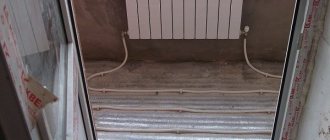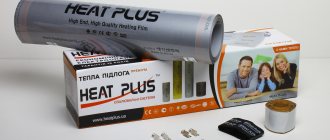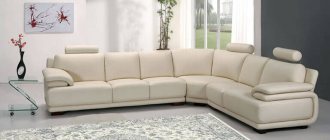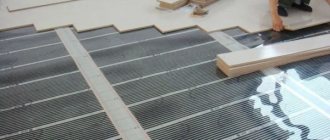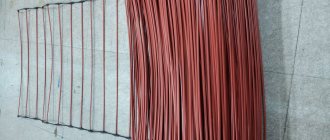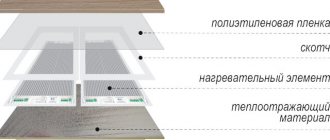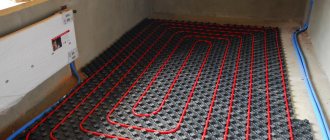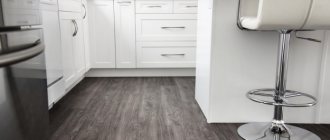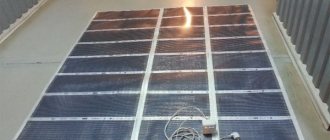Using heated floors allows you to ensure the most comfortable temperature conditions in the room, changing the indicators at your discretion. The system can be used both as an effective addition to radiator heating and as a complete replacement for it.
Types of heated floors
Water and electric varieties of heated floors are available for sale. Electrical systems, in turn, are classified into the following subtypes: cable, film and rod heated floors. Which option should you prefer? More on this later.
Types of heated floors and their features
Water heated floor
Installation technology for heated water floors
The operation of the system is based on the circulation of coolant - water - inside the installation. It is possible to supply water from the riser and from the centralized heating system. Direct circulation of water is ensured by the efforts of a pump, which is necessarily present in such systems. Of course, there is an option for installing a water heated floor without using a pump using the laws of gravity, but it is only suitable for use in small rooms.
An approximate schematic picture explaining the structure and operation of a water heated floor
Warm water floor
Advantages
- Relatively low installation costs.
- Relative cheapness of the coolant.
Flaws
- The need for strict adherence to technology and extreme caution in the process of pouring the screed so as not to damage the elements of the system.
- It is impossible to install the system in a city apartment. Today, performing this type of work is prohibited, because When water circulates through a heated floor, it returns to other consumers (neighbors) in a cooled state, which causes a lot of inconvenience.
Warm water floors can be installed in any type of premises, provided there is a source of hot water supply
About the features of infrared floors
Considering that in heated floors using infrared radiation, heating occurs somewhat differently, it is worth considering such floors separately. If the flow of current in floors using a cable heats up the cable itself and the floor from it, then in the case of using infrared film, everything happens differently.
The infrared rays that the film emits heat not only the floor, but also, passing through its surface, heat the walls, furniture and the person himself. The efficiency of this effect is higher than when using other heating systems.
Warm floor under tiles, cost of implementation and operation
Features of infrared radiation
However, such a warm floor, infrared, also has disadvantages, and they are associated precisely with IR radiation. At the same time, when current flows through the cable heating element, there is practically no radiation. And although the space around us is literally permeated with various types of electromagnetic radiation, many are simply afraid to create an additional source in the apartment.
Therefore, when deciding whether to choose infrared or cable heated floors, many for this reason stop their attention on cable.
How justified these fears are is a moot point. Supporters and opponents give a lot of arguments for and against, but such a discussion can go on for a very long time. The only argument that should be taken into account in such a situation would be obtaining from the relevant authorities (Ministry of Health, Consumer Protection Society, etc.) a conclusion and permission to use such a floor. In this case, the question of what to choose, film or cable underfloor heating, will receive confirmation at the level of authorized specialists.
Cable electric heated floor
Cable electric heated floor
Mounting tape
The system is based on wires made of special alloys. The composition of the alloys is selected in such a way that electrical energy is effectively “converted” into heat. To regulate the amount of heat generated, the system is equipped with a special thermostat.
Cable heated floors will last a very long time
Advantages
Among the key advantages of cable electric heating systems, the following points should be noted:
- long service life, much greater than that of the water system discussed above;
- relatively low operating costs. Although electricity costs much more than water, the cable version of the system consumes resources in relatively small quantities.
Flaws
This system also has its weaknesses, namely:
- generation of electromagnetic radiation during operation. Relevant for the cheapest models. For high-quality systems, this indicator does not exceed acceptable limits;
- high costs for installing the system.
When choosing a heating cable, give preference to products that have an ISO 14000 certificate - this document is a guarantee of the environmental safety of the system. Additionally, ask the seller to present a KIMA certificate. In the absence of the mentioned documents, it is recommended to refrain from purchasing the cable.
Heating cable structure
Film electric heating
Film electric heated floor
The design of the system is based on a special carbon heating film. When connected to the network, the system begins to produce infrared rays with the parallel release of anions. The functions of the emitter in this system are assigned to a special paste on a carbon (carbon) basis. It is applied to the material in parallel or curved stripes. In expensive versions of the system, the paste is usually applied continuously, resulting in higher heating efficiency.
Schematic diagram of connection
Electricity is supplied through copper-silver conductors. The main working elements of the system are sealed with layers of polyester. The power supply is regulated using a thermostat.
Film heated floor ENERPIA FILM
Film systems are widely represented in the assortment of many manufacturers of similar products. When choosing a brand, focus primarily on the reputation of the manufacturing company, user reviews, and personal preferences. If possible, enlist the help of specialists. Knowledgeable people will be able to give a realistic assessment of the tasks assigned to the heating system and help you choose the best option.
Advantages
Film infrared heated floors are easy to install with your own hands
The key advantage of film electric underfloor heating is its versatility in terms of compatibility with finishing materials. On top of such a film you can lay tiles, linoleum, vinyl panels, as well as laminate, carpet, etc.
The second important advantage of film systems is the possibility of arranging mobile heating based on them. For example, the film can be attached to the back of the carpet and removed when there is no need to use heating.
Electricity consumption of film heated floors
Flaws
Firstly, the main disadvantage of such a system is the large number of hidden contacts. In order for the further operation of the heated floor to be effective, reliable and safe, before accepting the system for permanent use, its performance must be thoroughly tested. In addition, the installation of the finishing coating must be carried out in strict accordance with the technology.
Secondly, when arranging the system, there is a need for additional financial expenses for the purchase of connectors. Without these products it is impossible to achieve high-quality contact between the wire and the film.
Thirdly, if ceramic tiles or other similar materials are laid on top of the heated floor, you will have to spend additional money on arranging the screed. At the same time, the consumption of the adhesive composition also increases - its layer cannot be thinner than 1.5 cm.
Rod electric heated floor
Rod electric heated floor
One of the latest developments in the heating equipment market. Characterized by high levels of reliability and environmental safety. The system is known under the self-explanatory nickname “intelligent heated floor”.
The heating is based on carbon rods interconnected and connected to a thermostat and the electrical network. This heated floor is offered to the end consumer in mat format.
Scheme for laying heated floors under tiles
Scheme for laying heated floors under carpet
Advantages
- No difficulties in thinking through subsequent furnishings. Core systems are characterized by self-regulation, i.e. Covering them with heavy objects is not scary for them, unlike their “brothers”. The rod electric heated floor will not overheat and break because of this.
- The possibility of unhindered filling with screed or various adhesive mixtures - such contacts are not dangerous for working elements.
- Possibility of arrangement in rooms with high humidity levels, on terraces and other open areas.
- High environmental friendliness compared to other types of heating systems.
UNIMAT - self-regulating rod heated floor
Flaws
The main disadvantage of rod electric heated floors is the high cost.
The second big drawback is the risk of purchasing a fake. The system really has good performance indicators, thanks to which it is widely popular among consumers. Unscrupulous manufacturers actively take advantage of this and produce counterfeit goods. For personal safety, please ask the seller to present the appropriate product certificates.
Advantages and disadvantages of heated floors
Types of heating circuit: water, electric, infrared
Existing radiator heating systems have significant disadvantages - the inability to regulate the temperature in apartments with centralized heating and zoned heat distribution.
It turns out that “your feet are cold, but your head is warm.” Warm floors are free of these disadvantages. In addition, the use of heated floors allows you to reduce the temperature of the coolant, which means saving up to 30% of your heating budget. The undoubted advantage of heated floors is the ability to control and regulate the temperature of the rooms and connect this function to the “smart home” system.
You will need a permit to install water floors
Of course, heated floors also have their disadvantages:
- for the installation of water heated floors in apartments with centralized heating, permission from the relevant services is required;
- the need for free air circulation from the floor, which limits the use of carpets, paths, and it is better to have furniture on legs;
- inertia of the system; First, the concrete screed is slowly heated, then the coating and air; this may take three to five hours;
- installation of underfloor heating systems reduces the height of the room by the thickness of the floor screed;
- difficulty of repair.
Of course, if all installation rules and operating standards for underfloor heating systems are followed, many disadvantages can be avoided, and this type of heating can be successfully used for many years. Some characteristics of heated floors can be seen from the table.
It should be remembered that heated floors are an outwardly invisible heating system that is not noticeable and does not in any way affect the overall appearance of the room.
Using this type of heating in small rooms, it will not take up space (like radiators, fireplaces and stoves), or interfere with passage and general access to various objects and common areas (shower, toilet).
Related article: Do-it-yourself reupholstery of fabric on an ironing board
Which system should you choose?
Which heated floor to choose
When choosing a specific heating system, you need to take into account many significant characteristics and additional conditions. First of all, this is the area of the heated room and the features of its location. For example, any system, including water, is suitable for use in a private home. You just need to objectively approach the assessment of the economic feasibility of using each available option. Along with this, when installing a heated floor in an apartment, it will not be possible to use a water system in accordance with legal restrictions.
In this case, you need to correctly assess the purpose of the system being installed. If it is used as additional heating, the main task of which is to maintain a comfortable microclimate for the owner, you can limit yourself to a budget film heated floor. When arranging the system for its subsequent use as the main heating, it is better to give preference to more powerful varieties, for example, a heating cable or, if this is a private house, a water heated floor.
Table. Areas and options for using heated floors
| Electrical system | Water system |
| Addition to main heating | Complete replacement of radiator heating |
| Heating of bathrooms, balconies, verandas and other similar premises | Addition to the main heating system, heating of any premises (relevant for private houses and other buildings in which the use of such installations is not prohibited) |
| Temporary quick heating of the floor in small rooms | |
| City apartments in which there is no possibility of installing a water system | |
| Installation of heating without carrying out associated capital work (relevant for the film variety) |
Under any circumstances, product quality should remain the priority factor for the consumer. Don't trust suspiciously cheap offers from dubious manufacturers. Give preference to certified products from well-known brands, and then you will not have any problems with the operation of either a water or electric heated floor in any of its variations.
Warm floors always provide a comfortable microclimate and a complete absence of drafts
Good luck with your choice!
Types of heated floors and their differences
All types of floor heating can be divided into two large categories:
- water from heating;
- electric.
There are two types of heated floors for apartments and houses: water and electric.
Which one is better? But we have to look. If we take into account the costs during the heating season, then water will be cheaper. But it requires a lot of installation costs, and it cannot be installed everywhere. And the point is not only the increased load on the ceiling, the point is that it cannot be installed everywhere.
Water heated floor
A water heated floor is usually connected to a heating system. Long polymer pipes are laid in a screed and connected through a manifold to a coolant supply source. If you have a private house or individual heating in an apartment, you can do this type of floor heating. Some new buildings also have special risers for connecting water heated floors. These are not all projects, but there are some.
Which heated floor is better in terms of operating efficiency? Water
In ordinary houses with any type of heating wiring, it is impossible to connect a heated floor to a riser. Not only will he most likely work through the stump-deck, but you will also freeze all your neighbors. After all, a water heated floor is tens of meters of thin pipe. Conventional heating is simply not designed for such hydraulic resistance. It simply will not be able to provide the required circulation rate. The water will be cold already halfway through the circuit and, completely cooled, will go to the neighbors. And the cost of installing a water heating device is very high. See for yourself: screed with insulation + pipes + engineering equipment (at a minimum you need a manifold with a mixing unit) + thermostat. And plus at least a month to set up this entire economy.
Electrical connection
Electric heated floors are simpler in terms of connection and installation - there are different types of heating elements that can be used for different floor designs and for different types of floor coverings. But there are also restrictions: the energy consumption limit allocated to an apartment or private house and the condition of the wiring. Of course, you can try to increase the limit, change the wiring. If you really need it, this is possible almost everywhere. But this, again, is time and expense.
Which heated floor to choose if you need to quickly put it into operation? Electric
If there is enough power and the wiring is in order, some types of electric heated floors can be laid and connected literally in a day. In one room this is quite possible. What can stop it? High energy consumption, which is becoming more and more expensive.
In general, there is an electric heated floor:
- for laying in a screed (heating cable);
- under tiles (cable mats);
- under laminate, linoleum, carpet and other heating-compatible coatings (film heated floors).
As you can see, there are solutions for almost any case. Installation methods, installation time and costs differ.
Alternative
There is also an “intermediate option” - liquid electric floors. This is a local floor heating system made from pipes with coolant (closed) with a heater built into the pipes. It is laid like a water floor in a screed, but is connected not to heating, but to electricity.
The idea is not bad, but the price, as well as the low maintainability of the system, are not encouraging. Pipes in a screed, they contain a coolant and a heating element. If something breaks, the heating is over. Although, as an alternative, it’s a very good option.

